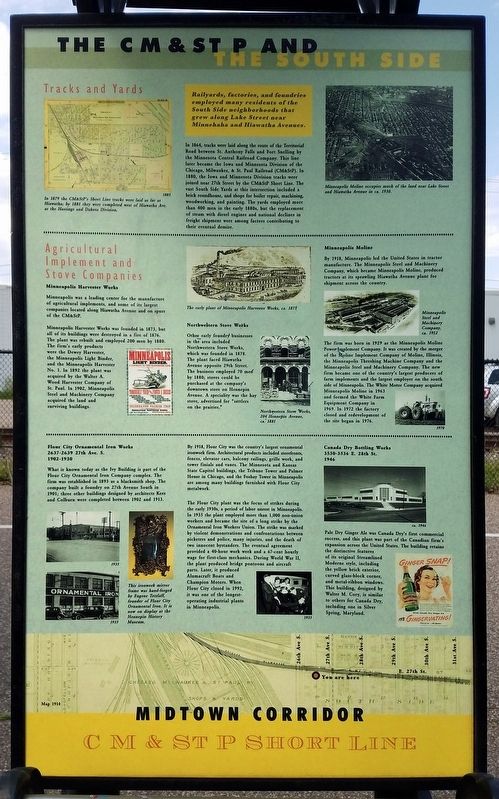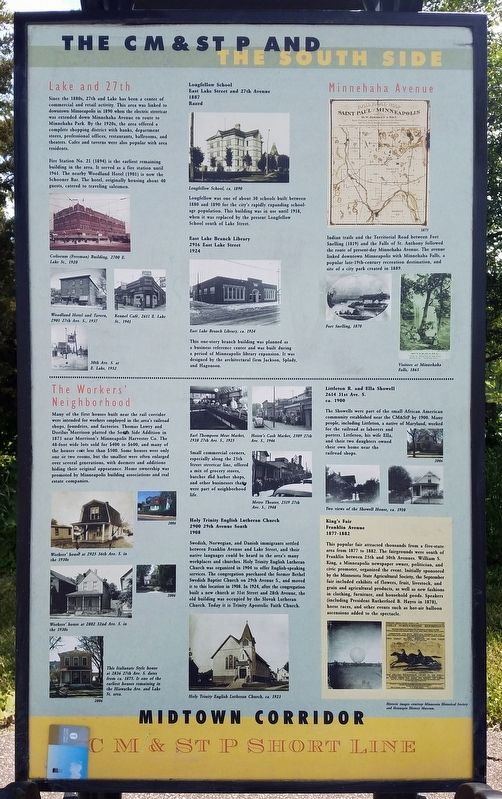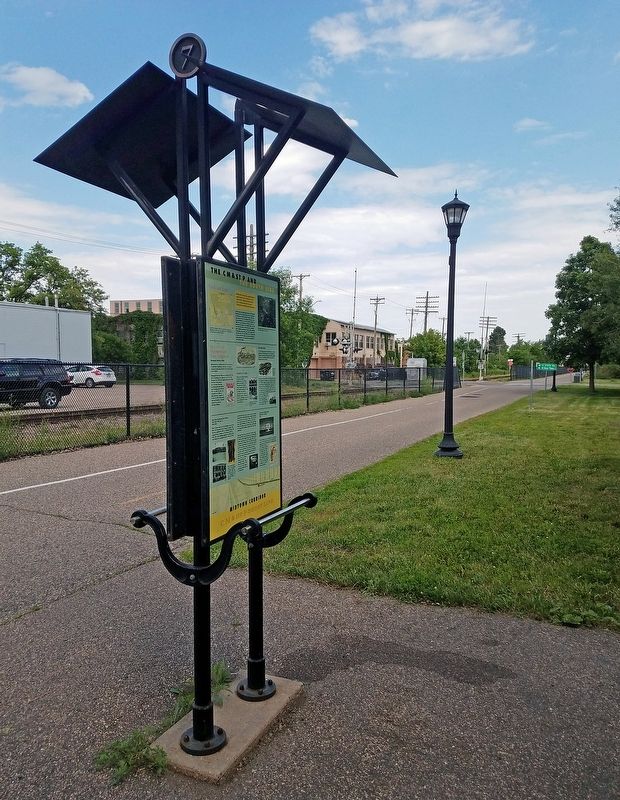Longfellow in Minneapolis in Hennepin County, Minnesota — The American Midwest (Upper Plains)
The CM&StP & the South Side
— Midtown Corridor: CM & St P Short Line —
In 1879 the CM&StP's Short Line tracks were laid as far as Hiawatha; by 1881 they were completed west of Hiawatha Ave. as the Hastings and Dakota Division.
Railyards, factories, and foundries employed many residents of the South Side neighborhoods that grew along Lake Street near Minnehaha and Hiawatha Avenues.
In 1864, tracks were laid along the route of the Territorial Road between St. Anthony Falls and Fort Snelling by the Minnesota Central Railroad Company. This line later became the Iowa and Minnesota Division of the Chicago, Milwaukee, & St. Paul Railroad (CM&StP). In 1880, the Iowa and Minnesota Division tracks were joined near 27th Street by the CM&StP Short Line. The vast South Side Yards at this intersection included a brick roundhouse, and shops for boiler repair, machining, woodworking, and painting. The yards employed more than 400 men in the early 1880s, but the replacement of steam with diesel engines and national declines in freight shipment were among factors contributing to their eventual demise.
Minneapolis Moline occupies much of the land near Lake Street and Hiawatha Avenue in ca. 1930.
Agricultural Implement and Stove Companies
Minneapolis Harvester Works
Minneapolis was a leading center for the manufacture of agricultural implements, and some of its largest companies located along Hiawatha Avenue and on spurs of the CM&StP.
Minneapolis Harvester Works was founded in 1873, but all of its buildings were destroyed in a fire of 1876. The plant was rebuilt and employed 200 men by 1880. The firm's early products were the Dewey Harvester, the Minneapolis Light Binder, and the Minneapolis Harvester No. 1. In 1892 the plant was acquired by the Walter A. Wood Harvester Company of St. Paul. In 1902, Minneapolis Steel and Machinery Company acquired the land and surviving buildings.
The early plant of Minneapolis Harvester Works, ca. 1875.
Northwestern Stove Works
Other early foundry businesses in the area included Northwestern Stove Works, which was founded in 1878. The plant faced Hiawatha Avenue opposite 29th Street. The business employed 0 men by 1880; stoves could be purchased at the company's downtown store on Hennepin Avenue. A speciality was the hay stove, advertised for "settlers on the prairies."
Northwestern Stove Works, 204 Hennepin Avenue, ca. 1881
Minneapolis Moline
By 1918, Minneapolis led the United States in tractor manufacture. The Minneapolis Steel and Machinery Company, which became Minneapolis Moline, produced tractors at its sprawling Hiawatha Avenue plant for shipment across the country.
Minneapolis Steel and Machinery Company, ca. 1912
The firm was born in 1929 as the Minneapolis Moline Power Implement Company. It was created by the merger of the Moline Implement Company of Moline, Illinois, and the Minneapolis Threshing Machine Company and the Minneapolis Steel and Machinery Company. The new firm became one of the country's largest producers of farm implements and the largest employer on the south side of Minneapolis. The White Motor Company acquired Minneapolis Moline in 1963 and formed the White Farm Equipment Company in 1969. In 1972 the factory closed and redevelopment of the site began in 1976.
Flour City Ornamental Iron Works
2637–2639 27th Ave. S.
1902–1930
What is known today as the Ivy Building is part of the Flour City Ornamental Iron Company complex. The firm was established in 1893 as a blacksmith shop. The company built a foundry on 27th Avenue South in 1901; three other buildings designed by architects Kees and Colburn were completed between 1902 and 1913.
By 1918, Flour City was the country's largest ornamental ironwork firm. Architectural products included storefronts, fences, elevator cars, balcony railings, grille work, and tower finials and vanes. The Minnesota and Kansas State Capitol buildings, the Tribune Tower and Palmer House in Chicago, and the Foshay Tower in Minneapolis are among many buildings furnished with Flour City metalwork.
The Flour City plant was the focus of strikes during the early 1930s, a period of labor unrest in Minneapolis. In 1935 the plant employed more than 1,000 non-union workers and became the site of a long strike by the Ornamental Iron Workers Union. The strike was marked by violent demonstrations and confrontations between picketers and police, many injuries, and the death of two innocent bystanders. The eventual agreement provided a 40-hour work week and a 67-cent hourly wage for first-class mechanics. During World War II, the plant produced bridge pontoons and aircraft parts. Later it produced Alumacraft Boats and Champion Motors. When Flour City closed in 1992, it was one of the longest-operating industrial plants in Minneapolis.
This ironwork mirror frame was hand-forged by Eugene Tetzlaff, founder of Flour City Ornamental Iron. It is now on display at the Hennepin History Museum.
Canada Dry Bottling Works
3530–3536 E. 28th. St.
1946
Pale Dry Ginger Ale was Canada Dry's first commercial success, and this plant was part of the Canadian firm's expansion across the United States. The building retains the distinctive features of its original Streamlined Moderne style, including the yellow brick exterior, curved glass-block corner, and metal-ribbon windows. This building, designed by Walter M. Cory, is similar to others for Canada Dry, including one in Silver Spring, Maryland.
Lake and 27th
Since the 1880s, 27th and Lake has been a center of commercial and retail activity. This area was linked to downtown Minneapolis in 1890 when the electric streetcar was extended down Minnehaha Avenue en route to Minnehaha Park. By the 1920s, the area offered a complete shopping district with banks, department stores, professional offices, restaurants, ballrooms, and theaters. Cafes and taverns were also popular with area residents.
Fire Station No. 21 (1894) is the earliest remaining building in the area. It served as a fire station until 1961. The nearby Woodland Hotel (1901) is now the Schooner Bar. The hotel, originally housing about 40 guests, catered to traveling salesmen.
Coliseum (Freeman) Building, 2700 E. Lake St., 1920
Woodland Hotel and Tavern, 2901 27th Ave. S., 1937
Kennel Café, 2611 E. Lake St., 1941
30th Ave S. at E. Lake, 1952
Longfellow School
East Lake Street and 27th Avenue
1887
Razed
Longfellow School, ca. 1890
Longfellow was one of about 30 schools built between 1880 and 1890 for the city's rapidly expanding school-age population. This building was in use until 1918, when it was replaced by the present Longfellow School south of Lake Street.
East Lake Branch Library
2916 East Lake Street
1924
This one-story branch building was planned as a business reference center and was built during a period of Minneapolis library expansion. It was designed by the architectural firm Jackson, Splady, and Hagonson.
Minnehaha Avenue
Indian trails and the Territorial Road between Fort Snelling (1819) and the Falls of St. Anthony followed the route of present-day Minnehaha Avenue. The avenue linked downtown Minneapolis with Minnehaha Falls, a popular late-19th-century recreation destination, and site of a city park created in 1889.
Fort Snelling, 1870
Visitors at Minnehaha Falls, 1865
The Workers' Neighborhood
Many of the first houses built near the rail corridor were intended for workers employed in the area's railroad shops, foundries, and factories. Thomas Lowry and Dorilus Morrison platted the South Side Addition in 1873 near Morrison's Minneapolis Harverster Co. The 48-foot wide lots sold for $400 to $600, and many of the houses cost less than $500. Some houses were only one or two rooms, but the smallest were often enlarged over several generations, with dormers and additions hiding their original appearance. Home ownership was promoted by Minneapolis building associations and real estate companies.
Worker's house at 2925 36th Ave. S. in the 1930s/2006
Workers' house at 2802 32nd Ave S. in the 1930s/2006
This Italianate Style house at 2836 27th Ave. S. dates from ca. 1875. It one of the earliest houses remaining in the Hiawatha Ave. and Lake St. area.
Earl Thompson Meat Market, 2938 27th Ave. S., 1925
Hoien's Cash Market, 2509 27th Ave. S., 1946
Metro Theater, 2519 27th Ave. S., 1948
Small commercial corners, especially along the 25th Street streetcar line, offered a mix of grocery stores, butcher and barber shops, and other businesses that were part of neighborhood life.
Holy Trinity English Lutheran Church
2900 29th Avenue South
1908
Swedish, Norwegian, and Danish immigrants settled between Franklin Avenue and Lake Street, and their native languages could be heard in the area's many workplaces and churches. Holy Trinity English Lutheran Church was organized in 1904 to offer English-speaking services. The congregation purchased the former Bethel Swedish Baptist Church in 29th Avenue S., and moved it to this location in 1908. In 1924, after the congregation built a new church at 31st Street and 28th Avenue, the old building was occupied by the Slovak Lutheran Church. Today it is Trinity Apostolic Faith Church.
Holy Trinity English Lutheran Church, ca. 1923
Littleton R. and Ella Showell
2614 31st Ave. S.
ca. 1900
The Showells were part of the small African American community established near the CM&StP by 1900. Many people, including Littleton, a native of Maryland, worked for the railroad as laborers and porters. Littleton, his wife Ella, and their two daughters owned their own home near the railroad shops.
Two views of the Showell House, ca. 1910
King's Fair
Franklin Avenue
1877–1882
This popular fair attracted thousands from a five-state area from 1877 to 1882. The fairgrounds were south of Franklin between 25th and 30th Avenues. William S. King, a Minneapolis newspaper owner, politician, and civic promoter, organized the event. Initially sponsored by the Minnesota State Agricultural Society, the September fair included exhibits of flowers, fruit, livestock, and grain and agricultural products, as well as new fashions in clothing, furniture, and household goods. Speakers (including President Rutherford B. Hayes in 1878), horse races, and other events such as hot-air balloon ascensions added to the spectacle. (Marker Number 7.)
Topics. This historical marker is listed in these topic lists: African Americans • Entertainment • Industry & Commerce • Railroads & Streetcars. A significant historical year for this entry is 1879.
Location. 44° 57.216′ N, 93° 14.029′ W. Marker is in Minneapolis, Minnesota, in Hennepin County. It is in Longfellow. Marker can be reached from the Midtown Greenway east of 26th Avenue S, on the right when traveling east. The marker is on the Midtown Greenway rail trail, between 26th and 27th Avenue S. Touch for map. Marker is at or near this postal address: 2645 26th Avenue S, Minneapolis MN 55406, United States of America. Touch for directions.
Other nearby markers. At least 8 other markers are within walking distance of this marker. Minneapolis-Moline (approx. 0.4 miles away); 2629 East Lake: Minnehaha Grill (approx. 0.4 miles away); Longfellow School (approx. 0.4 miles away); 2700 East Lake: Coliseum Building / Freeman's Department Store (approx. 0.4 miles away); 2721-23 East Lake: Lake Theater (approx. 0.4 miles away); 3010 Minnehaha Avenue South: Fire Station No. 21 (approx. 0.4 miles away); 3012 Minnehaha Avenue South: Lauritzen Wagon and Blacksmith Shop (approx. 0.4 miles away); Snelling Avenue: African American Community (approx. 0.4 miles away). Touch for a list and map of all markers in Minneapolis.
Credits. This page was last revised on February 12, 2023. It was originally submitted on December 28, 2022, by McGhiever of Minneapolis, Minnesota. This page has been viewed 139 times since then and 16 times this year. Photos: 1, 2, 3. submitted on December 28, 2022, by McGhiever of Minneapolis, Minnesota. • J. Makali Bruton was the editor who published this page.


